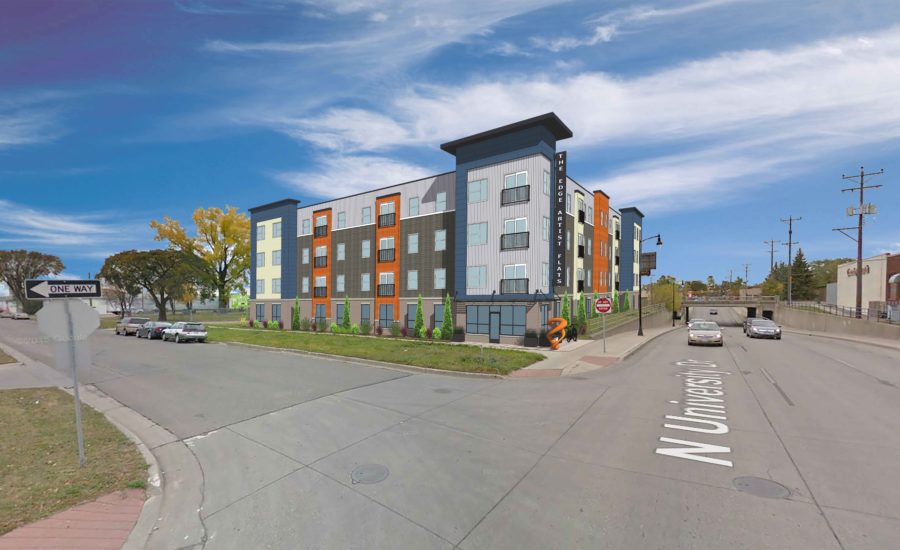The Edge Artist Flats Development Award
October 8, 2018

Seven housing developments that will serve vulnerable families and individuals have received funding from the North Dakota Housing Finance Agency (NDHFA), including The Edge Artist Flats, which M+A Design, Inc. is the architectural designer.
The awards were made through three federal programs—$3.16 million in low-income housing tax credit (LIHTC) authority, $2.72 million from the National Housing Trust Fund (HTF), and $460,000 from the Neighborhood Stabilization Program (NSP)—and $2.65 million from the state’s Housing Incentive Fund (HIF).
“The projects that North Dakota Housing Finance Agency selected support the state’s efforts to address behavioral health and criminal justice issues while ensuring North Dakota’s aging and disabled households and lower-wage workers have safe and affordable housing as well,” said Jolene Kline, NDHFA executive director. “By ensuring that our most vulnerable state residents have a safe and affordable place to call home, we reduce the overall burden placed on the communities and our state.”
The developments receiving the latest awards are:
· Edwinton Place in Bismarck, a Housing First project spearheaded by Burleigh County Housing Authority, was awarded $813,000 in LIHTCs. NDHFA also made commitments of $1,026,147 from the HTF, $500,000 from HIF, and $460,000 from NSP. It will provide permanent supportive housing for 40 individuals coming directly out of homelessness;
· The Edge Artist Flats in Fargo, a Commonwealth Development Corp. and M+A Design project, received $740,000 in LIHTCs and $1,369,263 from the HTF. The 42-unit, family-friendly development will provide supportive services to its disabled tenants and to households at risk of homelessness;
· HomeField 2 Apartments in Fargo is the second phase of a Beyond Shelter, Inc. (BSI) development. NDHFA awarded $504,437 in LIHTCs to support the development of 39 senior apartments, including eight accessible units;
· Ellendale Apartments, an Affordable Housing Developers, Inc., acquisition and rehab project, was awarded $755,000 from HIF to support the redevelopment of a 32-unit property that will provide accessibility improvements to improve the livability of the property for its elderly tenants;
· Pure Downtown in Grand Forks, a project of Dakota Commercial, received $1.1 million through HIF to reserve 25 of its 50 apartments for low- to moderate-income households;
· Dakota Heights in West Fargo, a Southhill Properties project, received $425,100 in LIHTCs. The senior housing project will have a vacancy preference for elderly veterans with Veterans Affairs Supportive Housing vouchers. Six of the 30 units will be reserved as permanent supportive housing for individuals with physical and intellectual disabilities; and
· Grace Gardens in West Fargo, a joint venture of the YWCA of Cass Clay and BSI, received $672,500 in LIHTCs. NDHFA also made a commitment of $325,549 from the HTF and $500,000 from HIF. The supportive housing project will serve 30 households at risk of homelessness, many of whom are transitioning from domestic violence.
HomeField 2 Apartments is the second phase of a Beyond Shelter, Inc., development in Fargo, N.D.. The 39-unit development for seniors received $504,437 in low-income housing tax credits from the North Dakota Housing Finance Agency.
About the programs
NDHFA received 27 total applications for assistance from 14 projects during its fall 2017 funding rounds. “The greatest demand was for support from the LIHTC and the HTF programs, more than twice what the programs could provide,” said Kline.
LIHTCs provide key funding for the construction or rehabilitation of rental housing for lower-income households.
The purpose of the HTF is to increase and preserve the supply of housing for extremely low-income households, including homeless families.
NSP supports the acquisition of foreclosed, abandoned, or vacant properties in targeted areas for redevelopment into affordable rental housing.
And HIF, the only state-funded program, strengthens communities by supporting the development or preservation of rental housing for essential service workers and low- to moderate-income households.
Source: Affordable Housing Finance
Back to All